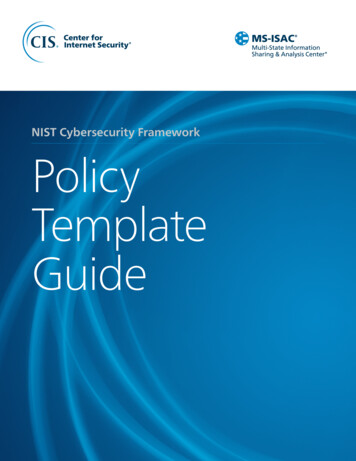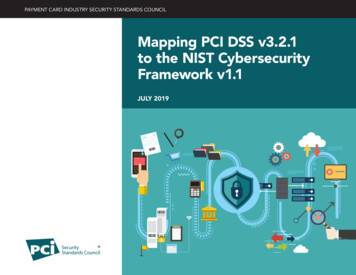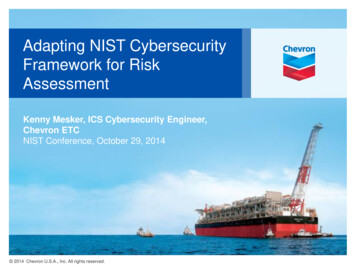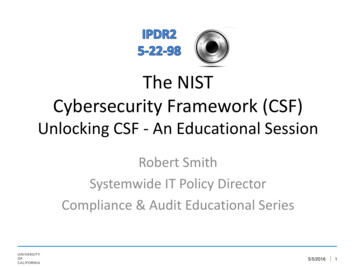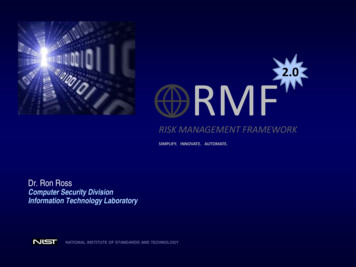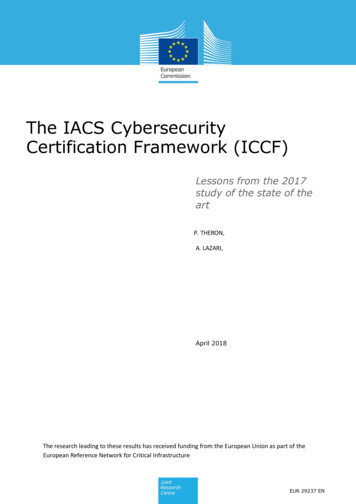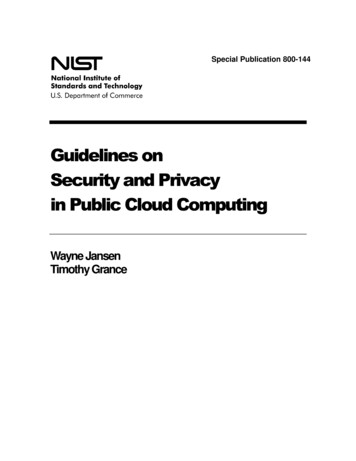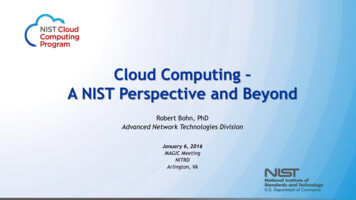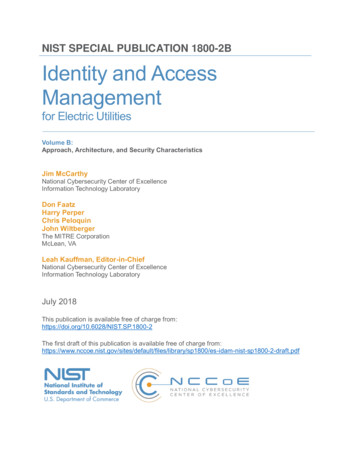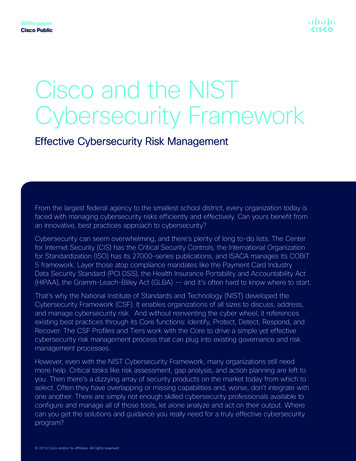
Transcription
White paperCisco PublicCisco and the NISTCybersecurity FrameworkEffective Cybersecurity Risk ManagementFrom the largest federal agency to the smallest school district, every organization today isfaced with managing cybersecurity risks efficiently and effectively. Can yours benefit froman innovative, best practices approach to cybersecurity?Cybersecurity can seem overwhelming, and there’s plenty of long to-do lists. The Centerfor Internet Security (CIS) has the Critical Security Controls, the International Organizationfor Standardization (ISO) has its 27000-series publications, and ISACA manages its COBIT5 framework. Layer those atop compliance mandates like the Payment Card IndustryData Security Standard (PCI DSS), the Health Insurance Portability and Accountability Act(HIPAA), the Gramm-Leach-Bliley Act (GLBA) -- and it’s often hard to know where to start.That’s why the National Institute of Standards and Technology (NIST) developed theCybersecurity Framework (CSF). It enables organizations of all sizes to discuss, address,and manage cybersecurity risk. And without reinventing the cyber wheel, it referencesexisting best practices through its Core functions: Identify, Protect, Detect, Respond, andRecover. The CSF Profiles and Tiers work with the Core to drive a simple yet effectivecybersecurity risk management process that can plug into existing governance and riskmanagement processes.However, even with the NIST Cybersecurity Framework, many organizations still needmore help. Critical tasks like risk assessment, gap analysis, and action planning are left toyou. Then there’s a dizzying array of security products on the market today from which toselect. Often they have overlapping or missing capabilities and, worse, don’t integrate withone another. There are simply not enough skilled cybersecurity professionals available toconfigure and manage all of those tools, let alone analyze and act on their output. Wherecan you get the solutions and guidance you really need for a truly effective cybersecurityprogram? 2019 Ciscoand/oraffiliates.All rightsAllreserved. 2019Ciscoitsand/orits affiliates.rights reserved.1
White paperCisco PublicLet Cisco helpIn the next few pages, we’llshow how Cisco’s effectivesecurity aligns with the NISTCybersecurity Framework.We’ll list each Frameworkfunction and category, andexplain exactly how Ciscoproducts and serviceshelp you accomplish eachspecific Framework goal.Our solutions are simple,open, and automated tointeroperate at every level ofthe security stack, not onlyacross the Cisco portfoliobut also with other vendors’products. Furthermore, oursolutions build industryleading, actionable Talosthreat intelligence directlyinto them. With Cisco, youcan take a new approachto cybersecurity, adoptthe Framework, andbolster cyber defensesand readiness.Cybersecurity Framework BasicsThe best source of Framework information is NIST itself, and the completeFramework document, newsletters, and other resources are freely availablefrom www.nist.gov/cyberframework. Figure 1 summarizes the Framework’score structure for convenience, but please refer to the NIST Frameworkdocument for complete details.Figure 1: Framework Core StructureCisco Security and theNIST Cybersecurity FrameworkAsset ManagementTechnical ControlsNon-technical ControlsCiscoCisco Services orTechnology Partners Business EnvironmentID GovernanceRisk Assessment Risk Management Supply Chain Access Control Awareness TrainingPRDEData Security Info Protection Process Maintenance Protective Technology Anomalies and Events Continuous Monitoring Detection Process Response Planning CommunicationsRSRC Analysis Mitigation Improvements Recovery Planning Improvements Communications Each Category has several Subcategories and multiple InformativeResources, so the entire Framework Core cannot fit into small summarytable. That’s why Figure 1 shows only the Subcategories and InformativeResources column headings but the fields are blank. Please see theFramework document’s Appendix A, “Framework Core” for complete details.reserved. 2019 Cisco and/or its affiliates. All rights reserved.2
White paperCisco PublicCisco Supports the NIST Cybersecurity FrameworkCisco’s comprehensive cybersecurity product and services portfolio defends organizations throughout the worldagainst today’s advanced threats. Figure 2 shows how our cybersecurity products map to the NIST CybersecurityFramework:Figure 2: Cisco Security Product Aligns with the FrameworkAMP/Threat GridStealthwatch(with rustsecDuoAnyConnectMerakiSMCiscoServicesAccess ManagementIDBusiness EnvironmentNon-technical control areaGovernanceNon-technical control areaRisk AssessmentRisk ManagementSupply ChainNon-technical control areaCisco Security and Trust Organization (S&TO)Access ControlAwareness TrainingPRNon-technical control areaData SecurityInfo Protection ProcessNon-technical control areaMaintenanceProtective TechnologyAnomalies and EventsDERSContinuous MonitoringDetection ProcessNon-technical control areaResponse PlanningNon-technical control areaCommunicationsNon-technical control areaAnalysisMitigationRCImprovementsNon-technical control areaRecovery PlanningNon-technical control areaImprovementsNon-technical control areaCommunicationsNon-technical control areaThe green boxes show where Cisco Security products supports the Framework’s desired outcomes. For example,Cisco Identity Services Engine (ISE) profiles and categorizes devices when they attempt to connect to the network.Knowing what’s on the network is a key step toward effective Asset Management (Identify function). And CiscoStealthwatch baselines network traffic patterns and detect suspicious activity, critical capabilities for the Anomaliesand Events category (Detect function).Cybersecurity products alone cannot cover the entire Framework. For example, the Awareness and Training category(Protect function) ensures that people are provided with cybersecurity awareness education and are adequatelytrained to perform their duties. The Detection Processes category (Detect function) ensures that people understandtheir roles; that detection processes are tested and improved; and event detection information is communicated andreported properly. Therefore, Figure 2 shows the non-technical control areas; that is, those categories where peopleand process related controls (and not technical controls) are required. 2019 Cisco and/or its affiliates. All rights reserved. 3
White paperCisco PublicCisco Security Services can help with all areas of the Framework, including the non-technical controls. We can helpyour organization adopt the Framework and use it to effectively manage cybersecurity risk. Figure 3 shows how ourAdvisory, Integration and Managed services can help you adopt the NIST Cybersecurity Framework:Figure 3: Cisco Security Services: NIST CSF s Management Business Environment Governance Risk Assessment Risk Management Supply Chain Access Control Awareness Training Data Security Info Protection Process Maintenance Protective Technology Anomalies and Events Continuous Monitoring Detection Process Response Planning Communications Analysis Mitigation Improvements Recovery Planning Improvements Communications Cisco Advisory Services has the right people and process knowledge and best practices to help you understand,plan, and act on all areas of the NIST Cybersecurity Framework. Our Integration Services can help you make the mostof your technology investments, and our Managed services can help you implement new controls even if you don’thave the manpower in-house.In the coming pages, we’ll explore each of the NIST CSF core functions – Identify, Protect, Detect, Respond,and Recover – and we’ll offer more detail around the green boxes we showed in Figure 2 (Cisco Products)and Figure 3 (Cisco Services). 2019 Cisco and/or its affiliates. All rights reserved. 4
White paperCisco PublicCisco Solutions for the Identify (ID) ng to NIST, the purpose of the Identify function is to “develop the organizational understanding to managecybersecurity risk to systems, assets, data, and capabilities.” Part of that organizational understanding is visibility intowhat you have; that is, it’s difficult to protect something if you don’t know that you have it. That’s why Cisco’s deliverscritical discovery capabilities; that is, identifying and categorizing systems, assets, and data on a continuous basis.Let’s take a closer look at each category within the Identify function.ID.AM: Asset Management. NIST defines the Asset Management category’s goal as “the data, personnel, devices,systems, and facilities that enable the organization to achieve business purposes are identified and managedconsistent with their relative importance to business objectives and the organization’s risk strategy.”Subcategories include physical device inventories (ID.AM-1) and software application inventories (ID.AM-2).How Cisco solutions map to the Asset Management category: Cisco ISE discovers and accurately identifies devices connected to wired, wireless, and virtualprivate networks. It gathers this information based on what’s actually connecting to the network,a key step toward building and maintaining accurate physical device inventories (ID.AM-1). Cisco Firepower provides visibility into software applications running on your network, a key steptoward building and maintaining accurate software application inventories (ID.AM-2). Cisco Meraki Systems Manager delivers cloud-based endpoint management and controlfor the provisioning, management and security of mobile and desktop devices. Cisco Cloudlock is a cloud-native CASB and Cloud Cybersecurity Platform that helps organizationssecurely leverage the cloud for apps they buy and build. Cloudlock delivers security for cloudapplications and platforms, including SaaS (Google G Suite, Box, Dropbox, Salesforce, ServiceNow,Slack) IaaS (Amazon Web Services), and PaaS (Force.com). Cisco Umbrella, our leading SecureInternet Gateway, also integrates CASB features like discovery and control of SaaS apps. Duo’s endpoint visibility allows you to see, track and report on all end user devices from a single dashboard. Cisco Advisory Services help you analyze your asset management capabilities today, and provides youwith the information you need to improve tomorrow. We can not only advise on device inventory strategies(ID.AM-1 and ID.AM-2), but also help you map organizational communication and data flow (ID.AM-3),catalog external systems (ID.AM-4), prioritize and classify resources (ID.AM-5) and establish cybersecurityroles and responsibilities both inside and outside of your agency or organization. (ID.AM-6). Cisco Advanced Malware Protection identifies and blocks the malicious code that is so often the cause of dataleaks today (PR.DS-5), while protecting data stored on systems (PR.DS-1) and traversing across networks (PR.DS-2). Cisco Stealthwatch analyzes NetFlow records and alerts on evidence of information loss – for example,when large amounts of data unexpected leave a database server directly for the internet. Stealthwatch is anessential data leak protection solution (PR.DS-5) with absolutely minimal network performance impact. 2019 Cisco and/or its affiliates. All rights reserved. 5
White paperCisco PublicID.BE: Business Environment. NIST defines the Business Environment category’s goal as “the organization’s mission,objectives, stakeholders, and activities are understood and prioritized; this information is used to inform cybersecurityroles, responsibilities, and risk management decisions.” This category requires people and process controls, nottechnical controls.Subcategories include the identification and communication of the organization’s supply chain role (ID.BE-1) and itscritical infrastructure role (ID.BE-2), and the establishment and communication of the organization’s priority missionand objectives (ID.BE-3), service delivery dependencies (ID.BE-4), and resiliency requirements (ID.BE-5).How Cisco solutions map to the Business Environment category: Cisco Advisory Services’ Strategy & Risk Management services include assessments, planning and guidance todeliver a holistic view of IT risks from the perspective of your business environment. It helps you understand andcommunicate your role in the supply chain (ID.BE-1) and as a critical infrastructure provider, if applicable (ID.BE-2).It enables you to establish and communicate your organization’s priorities (ID.BE-3), service delivery dependences(ID.BE-4), and contingency planning requirements including cyber incident response strategies (ID.BE-5).ID.GV: Governance. NIST defines the Governance category’s goal as “the policies, procedures, and processesto manage and monitor the organization’s regulatory, legal, risk, environmental, and operational requirements areunderstood and inform the management of cyber risk.” This category requires people and process controls, nottechnical controls.Subcategories include cybersecurity policy establishment (ID.GV-1), roles and responsibilities coordination(ID.GV-2), legal and regulatory requirements understanding (ID.GV-3), and assurance that governance andrisk management process address cybersecurity risks (ID.GV-4).How Cisco solutions map to the Governance category: Cisco Advisory Services’ Strategy & Risk Management services provide strategic planning and guidance thatare essential for all four of these subcategories (ID.GV-1 through ID.GV-4). Our Security Design Assessment(SDA) services assess security business goals and help reduce regulatory compliance exposure (ID.GV-3).ID.RA: Risk Assessment. NIST defines the Risk Assessment category’s goal as “the organization understands thecybersecurity risk to organizational operations (including mission, functions, image, or
for Standardization (ISO) has its 27000-series publications, and ISACA manages its COBIT 5 framework. Layer those atop compliance mandates like the Payment Card Industry Data Security Standard (PCI DSS), the Health Insurance Portability and Accountability Act (HIPAA), the Gramm-Leach-Bliley Act (GLBA) -- and it’s often hard to know where to start. That’s why the National Institute of .
